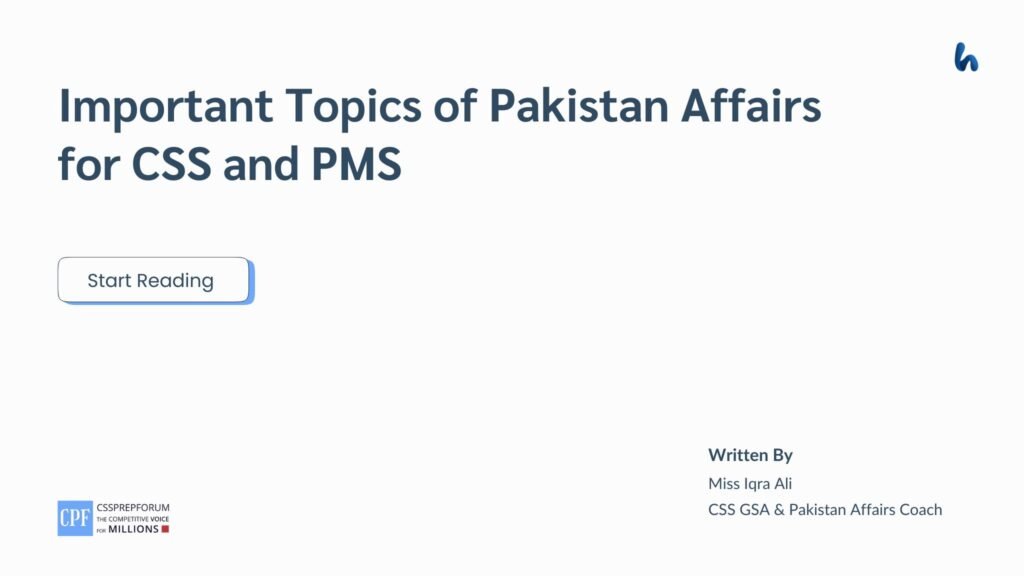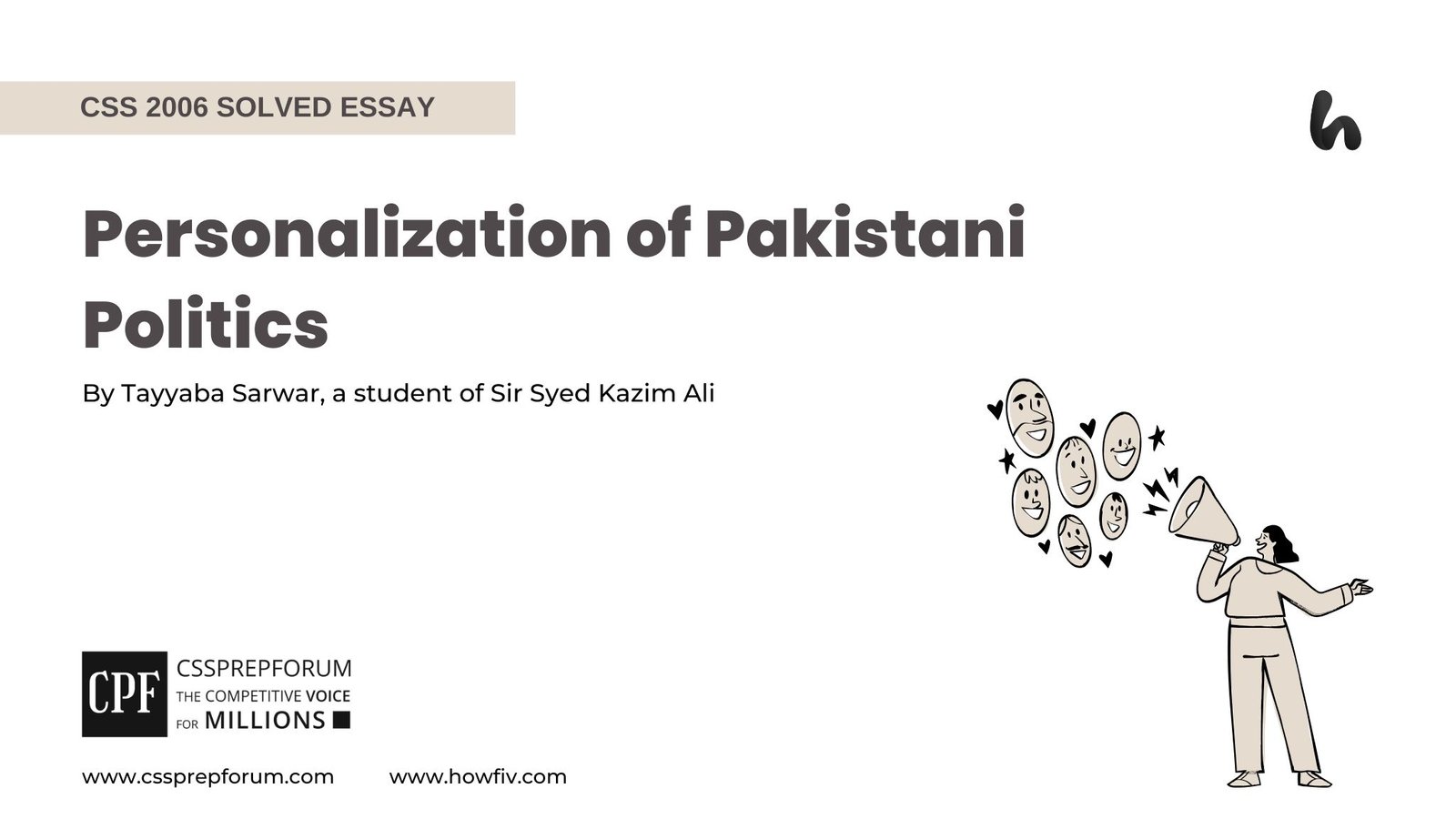To navigate Pakistan Affairs in CSS and PMS examinations, aspirants must have a grip on high-stakes topics through critical analysis and interdisciplinary insight. The following blogs are a detailed guide on the important topics of Pakistan Affairs for the competitive exams.

Pakistan Affairs is an expansive subject that interlaces history, politics, economy, and international relations, demanding a multifaceted analytical approach. The examination for CSS and PMS requires aspirants to dive deep into the nation’s geopolitical intricacies, ideological foundations, and policy challenges. Pakistan’s strategic positioning, evolving diplomatic engagements, and socio-political dynamics make it a compelling case study of resilience and struggle. Understanding the undercurrents that shape governance, national security, and economic frameworks is imperative, as these themes are not only central to the competitive exams but also integral to the broader discourse on Pakistan’s trajectory. Acing this subject necessitates more than just memorization; it demands critical thinking, a command of historical contexts, and an ability to connect past precedents with contemporary realities. Within this vast landscape, certain topics emerge as indispensable, recurring almost predictably in past papers and requiring an astute grasp to navigate successfully.
Among the plethora of topics, foreign policy invariably emerges as the cynosure, its tentacles stretching into Current Affairs and International Relations as well. With global diplomacy transforming into an intricate chessboard, Pakistan’s foreign policy remains a tightrope walk, oscillating between strategic alliances, economic dependencies, and national security imperatives. From the shifting sands of US-Pak relations to the ever-mercurial dynamics with India and Afghanistan, aspirants must stay attuned to diplomatic oscillations. Questions often pivot around CPEC’s geopolitical ramifications, Pakistan’s role in regional blocs like SAARC and OIC, and its diplomatic posture amid the evolving global order. Understanding this domain is not merely an academic exercise but an intellectual necessity, given its cross-cutting relevance in multiple subjects.
Pakistan’s geostrategic location, a veritable double-edged sword, dominates the discourse annually. Straddling the fault lines of South Asia, Central Asia, and the Middle East, Pakistan’s geographical position has historically been both a boon and a bane. It bestows upon the nation strategic leverage but simultaneously renders it a battleground for competing hegemonies. From Cold War politics to the Great Game redux, from the War on Terror to contemporary US-China rivalry, Pakistan remains entangled in geopolitical manoeuvrings. The country’s proximity to the Persian Gulf, its role in the Belt and Road Initiative, and its vulnerabilities in the face of hybrid warfare make this topic indispensable. Candidates must grasp the nuances of strategic depth, the significance of Gwadar Port, and the transcontinental aspirations that define Pakistan’s location in the global power matrix.
Interwoven within the national fabric, ethnic fissures and sectarian fault lines pose an existential conundrum. Pakistan, a mosaic of diverse ethnicities, has grappled with centrifugal forces that periodically test its unity. The Baluchistan conundrum, Pashtun grievances, Sindhi nationalism, and the sporadic flare-ups in Gilgit-Baltistan all underscore the salience of identity politics. Furthermore, sectarian schisms have exacerbated internal security challenges, morphing into a quagmire of violent extremism. The interplay of historical injustices, economic disenfranchisement, and external machinations often foments discord, necessitating policy interventions aimed at fostering inclusivity. The recurrent presence of ethnicity and sectarianism in past papers underscores its gravity, making it a topic that aspirants must dissect with a clinical eye.
Inextricably linked to ethnic dynamics is the broader theme of national integration, a leitmotif of Pakistan’s internal discourse. The perennial tug-of-war between centralization and provincial autonomy continues to shape political trajectories. The post-18th Amendment landscape, resource allocation debates, and the simmering demand for new provinces elucidate the challenges of governance in a multi-ethnic polity. Beyond the structural realm, the notion of national cohesion transcends political boundaries, encompassing ideological, linguistic, and economic integration. Federalism, devolution of power, and social contract renegotiations remain at the heart of policy deliberations. The central question remains: how can Pakistan mold its heterogeneous populace into a cohesive national identity without resorting to coercion? With globalization reshaping nationalist narratives, the CSS and PMS syllabi inevitably probe this theme, compelling candidates to articulate pragmatic solutions.
An excursion into Pakistan’s constitutional and political history is imperative, with federalism and center-province relations occupying center stage. The ideological tussle between a unitary state and a decentralized federation has defined Pakistan’s constitutional evolution. The vicissitudes of the One Unit scheme, the tussle between parliamentary and presidential systems, and the oscillation between civilian and military rule furnish a rich analytical ground. The jurisprudence of constitutional amendments, particularly the 8th, 13th, and 18th Amendments, often becomes a focal point in exam questions. Beyond federalism, broader themes of political instability, judicial activism, and democratic transitions are recurrently scrutinized. Aspirants must not only recount historical developments but also evaluate contemporary political dynamics through a constitutional lens.
No discourse on Pakistan Affairs is complete without a dissection of the economy, an Achilles’ heel that perpetually looms large. Economic malaise, characterized by burgeoning debt, fiscal deficits, and anemic growth, has long plagued Pakistan. Structural reforms remain elusive, while IMF bailouts have become a Sisyphean cycle. The contours of economic governance, ranging from taxation policies to industrialization efforts, frequently permeate the CSS and PMS examination sphere. Additionally, the informal economy, remittance dependency, and trade imbalances add complexity to economic policymaking. Candidates must not merely regurgitate economic indicators but develop a critical perspective on policy efficacy, juxtaposing theoretical frameworks with ground realities.
Venturing into the annals of history, certain themes persist with remarkable regularity. Religious reformers and movements, whether in the form of Syed Ahmed Barelvi’s Jihad Movement or Shah Waliullah’s theological expositions, hold enduring relevance. The ideological genesis of Pakistan, encapsulated in the Aligarh Movement, the Two-Nation Theory, and the intellectual contributions of luminaries like Sir Syed Ahmad Khan, Allama Iqbal, and Quaid-e-Azam, forms a cornerstone of historical inquiry. Equally significant is the ideological consolidation post-Partition, with milestones such as the Objectives Resolution shaping Pakistan’s constitutional edifice. The cataclysmic fall of Dhaka, a watershed moment in the nation’s trajectory, continues to be revisited in the examination arena, demanding a nuanced understanding of political miscalculations, socio-economic disparities, and external interventions.
The Following is the Summary of the important topics of Pakistan Affairs
| Main Domain | Topics Included |
| Foreign Policy & Diplomacy | Pakistan-US Relations, Pakistan-India Relations, Pakistan-Afghanistan Relations, CPEC & Geopolitical Ramifications, Strategic Alliances, Changing Global Order |
| Geostrategic Significance of Pakistan | Both Traditional and Modern Significance, along the Challenges and Suggestions |
| International & Regional Organizations | Pakistan’s role in SAARC, OIC, ECO, SCO, UN Peacekeeping Missions, Regional Integration Efforts, Multilateral Diplomacy |
| Ethnicity & Sectarianism | Baluchistan Conflict, Sectarian Violence, Identity Politics, External Interference |
| National Integration & Federalism | 18th Amendment, Provincial Autonomy, Resource Allocation, New Provinces Demand, Federalism vs. Centralisation, Social Cohesion, Devolution of Power |
| Political & Constitutional Evolution | One Unit Scheme, Civil-Military Relations, Judicial Activism, 8th/13th/18th/26th Amendments, Democracy vs. Authoritarianism, Parliamentary vs. Presidential System |
| Economic Challenges & Policies | Debt Crisis, Fiscal Deficit, IMF Bailouts, Structural Reforms, Informal Economy, Taxation, Remittances, Industrial Policy, Trade Imbalance |
| Historical Movements & Ideological Roots | Two-Nation Theory, Aligarh Movement, Syed Ahmed Barelvi, Shah Waliullah, Sir Syed Ahmad Khan, Allama Iqbal, Objectives Resolution, Post-Partition Ideology |
| Major Historical Events | Creation of Pakistan, Fall of Dhaka, Partition Dynamics, Political Mistakes, External Interventions, Ideological Consolidation |
In sum, while the CSS and PMS syllabi encompass a broad spectrum, the aforementioned topics constitute the linchpin of Pakistan Affairs. Mastery over these themes is non-negotiable, as they repeatedly manifest in various iterations. Success hinges not on rote memorization but on a deep, analytical engagement with these subjects. A holistic approach, integrating historical perspectives with contemporary developments, is indispensable. Aspiring civil servants must not merely assimilate information but synthesize insights, critically evaluating Pakistan’s multifaceted challenges. In an era where the country’s destiny teeters on the precipice of transformation, those who seek to shape its future must first grasp the intricacies of its past and present.













